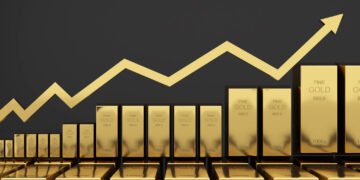Silver’s Unexpected Rise: The Shining Star of 2024
In the ever-shifting landscape of commodity investments, 2024 has brought an unexpected star to the forefront: silver. While gold and copper often steal the spotlight, it’s the understated gray metal that’s been quietly outperforming its more glamorous cousins. With a staggering 21% year-to-date increase, silver isn’t just outpacing other metals – it’s leaving the S&P 500 index in its dust.
The Paradox: Strong Performance, Weak Investor Interest
But here’s the kicker: despite this impressive performance, many investors seem to be giving silver the cold shoulder. It’s a peculiar scenario that’s leaving market watchers scratching their heads. Most silver bullion and silver-mining stock exchange-traded funds (ETFs) are experiencing net outflows this year, according to Morningstar data. Even more telling, U.S. Mint silver bullion coin sales have plummeted to 1.34 million ounces, less than half of the 3.4 million ounces sold through June last year.
Defying Economic Logic: Silver’s Surprising Strength
For those overlooking silver, it might be a costly mistake. The metal is currently trading around $30 an ounce, a level not seen since 2012. What makes this surge particularly intriguing is that it’s happening against a backdrop that conventional wisdom would suggest is unfavorable for precious metals. We’re in an environment of high interest rates, declining inflation, a robust stock market, and a U.S. economy that continues to grow. As Adrian Day, CEO of Adrian Day Asset Management, astutely points out, “This is exactly the opposite environment in which you should be investing” for silver.
The Dual Nature of Silver: Precious and Industrial
So, what’s driving this silver surge? While silver often dances to the same tune as gold, it has a trick up its sleeve that sets it apart: its industrial applications. Silver’s excellent conductivity makes it a crucial component in various industries, and it’s this dual nature as both a precious and industrial metal that’s fueling its current rally.
The global push towards electrification and the insatiable demand for more powerful semiconductors – the same factors boosting copper – are giving silver its moment in the sun. Interestingly, silver is also finding its way into the heart of the artificial intelligence revolution, being used in the powerful semiconductor chips that drive AI technologies.
The numbers tell a compelling story. The Silver Institute, an industry group, reported that industrial demand for silver reached record levels in 2023. Perhaps most striking was the 64% jump in demand from the solar panel industry. Looking ahead, the institute projects a further 20% increase in usage for 2024. This aligns perfectly with data from the Solar Energy Industries Association, which reported that the U.S. solar market saw its second-largest quarter of installed capacity in the first quarter of 2024, just shy of the record set in the previous quarter.
But it’s not just about solar panels. Robert Minter, director of ETF investment strategy at Abrdn, which issues the $1.3 billion Abrdn Physical Silver Shares ETF (ticker: SIVR), points to China as a significant driver of demand. China’s role is twofold: as the world’s largest manufacturer of solar panels and as a source of investment demand. Minter notes that physical silver in China is trading at a premium to spot prices, indicating strong local demand.
Silver’s Unique Market Dynamics
It’s important to understand that silver is more than just “poor man’s gold,” as David Morgan, publisher of the Morgan Report, a natural-resources newsletter, explains. While silver and gold often move in tandem, silver’s smaller market size makes it much more volatile. It’s also subject to seasonal trends, typically seeing sluggish action in the summer and greater volatility in fall and winter.
For investors looking to ride the silver wave, options are somewhat limited. Besides physical bars and coins, there are only a handful of non-leveraged/inverse ETFs available. The iShares Silver Trust (SLV), with assets of $13.2 billion, stands as the largest silver-backed ETF. For those interested in mining stocks, the Global X Silver Miners (SIL), with $1.1 billion in assets, is the largest silver-miner ETF. These funds have seen impressive gains in 2024, up 24% and 11% respectively.
However, equity investors might be surprised to learn that there are no pure-play silver-mining stocks. As Adrian Day points out, “The dirty little secret is most silver-mining companies do not have the majority of their revenue from silver.” This is particularly true for companies that also produce gold.
Silver’s Future: Industrial Demand and Supply Dynamics
Looking ahead, silver’s future seems increasingly tied to industrial demand rather than its traditional role as a precious metal. The robust growth in solar panel production has been a significant driver, but there’s always the possibility of this demand plateauing. However, it’s worth noting that silver used in photovoltaics is effectively locked up for years until those panels are recycled – if they’re recycled at all. This could potentially keep a significant portion of supply off the market for an extended period, potentially limiting how far prices might fall in the future.
Conclusion: Silver’s Moment in the Spotlight
As we navigate through 2024 and beyond, silver’s performance serves as a reminder of the complex and often counterintuitive nature of commodity markets. While traditional economic indicators might suggest a challenging environment for precious metals, silver is defying expectations and carving out its own path.
For investors, the message is clear: don’t underestimate the gray metal. Its unique position at the intersection of precious and industrial metals makes it a fascinating asset to watch. As the world continues its march towards renewable energy and advanced technologies, silver’s role – and potentially its value – may only grow!
Acknowledgment: This article was inspired by and includes information from "This Metal is a Hot AI Play. It’s Beating Gold and the Stock Market." published on Barrons.com. For more detailed insights, you can read the full article here.







